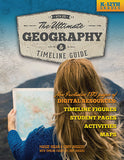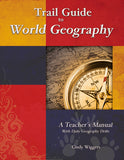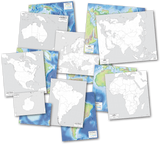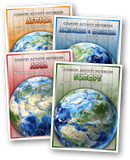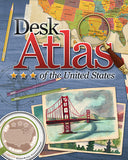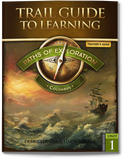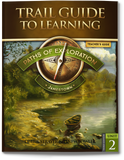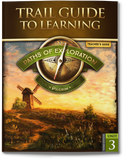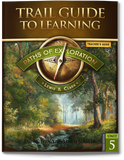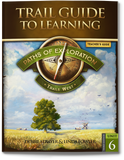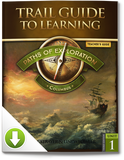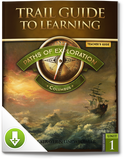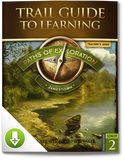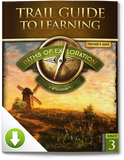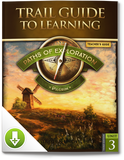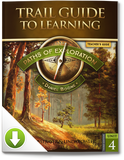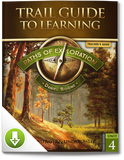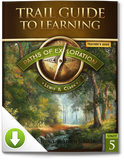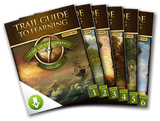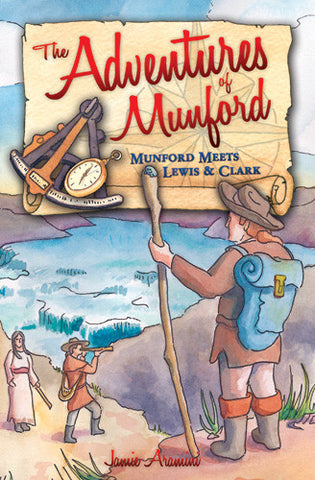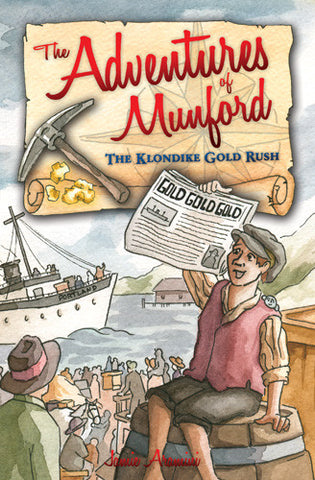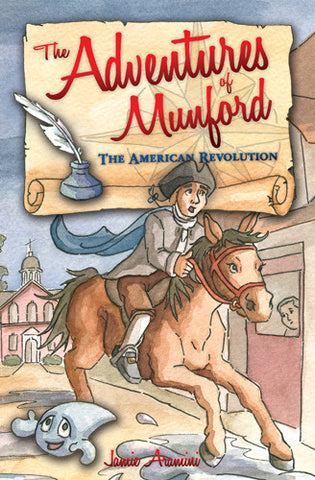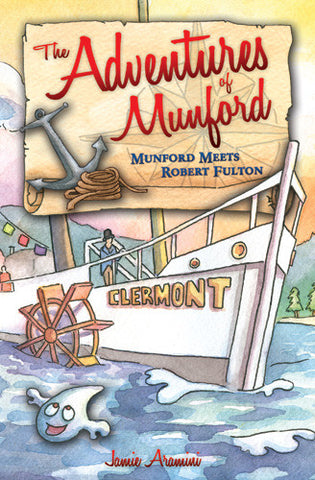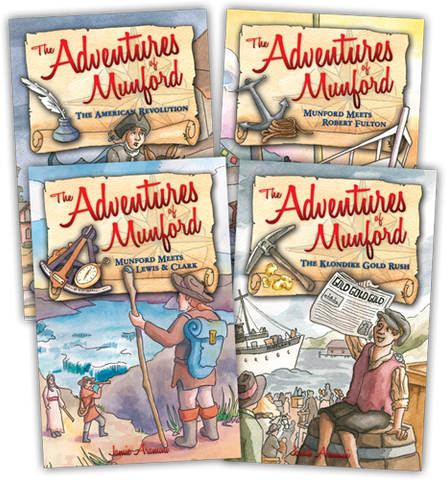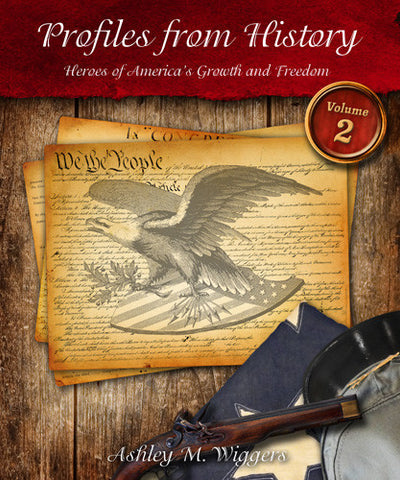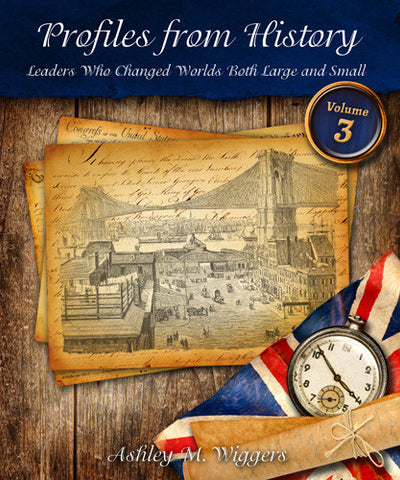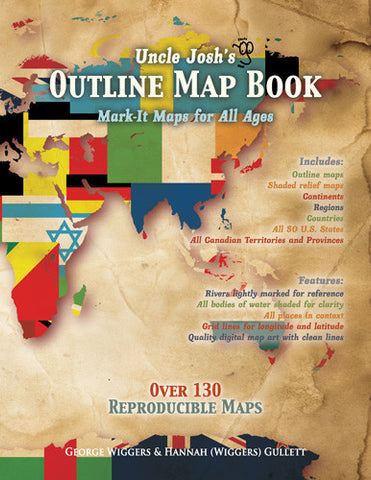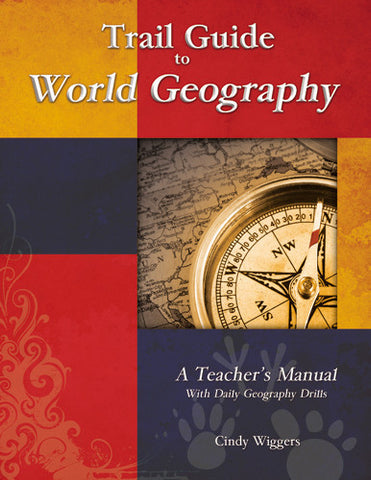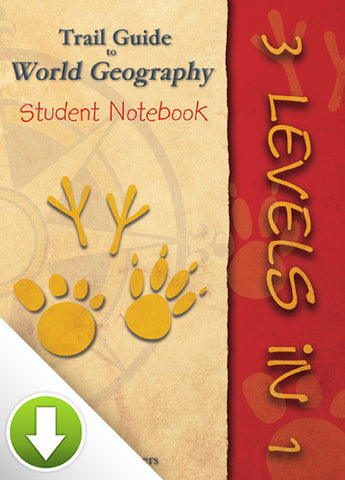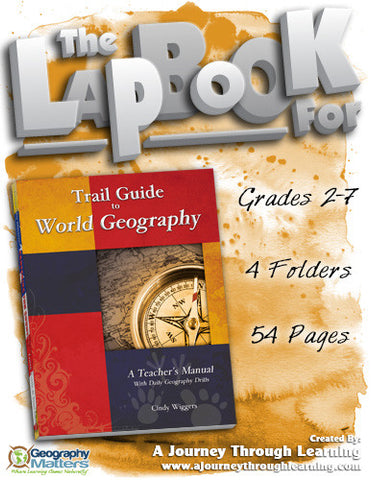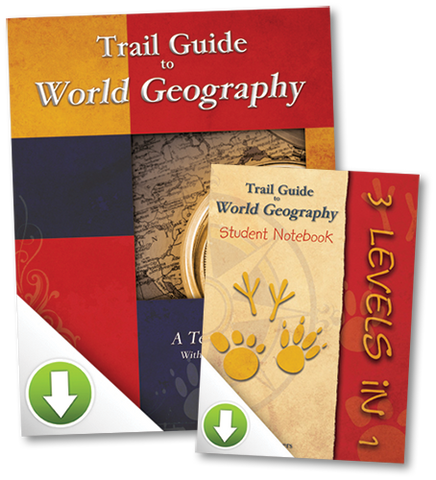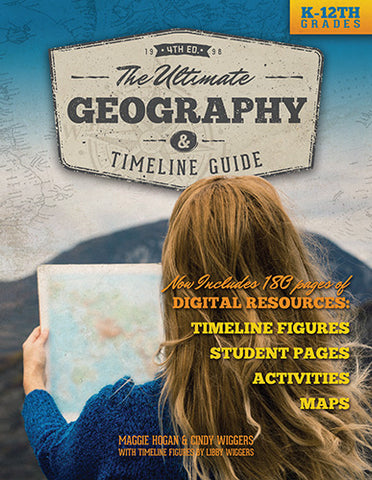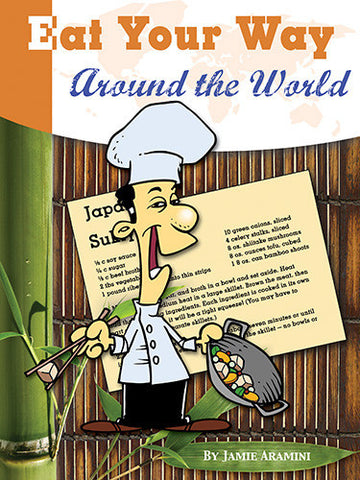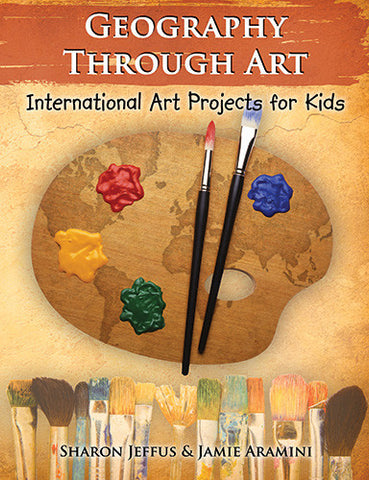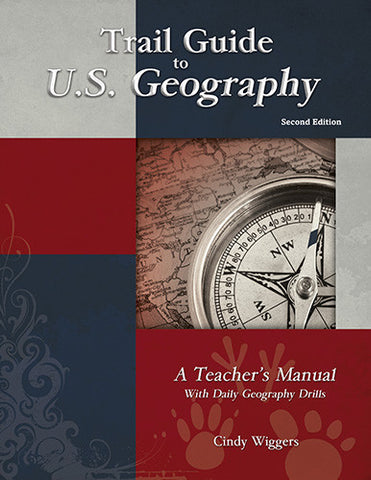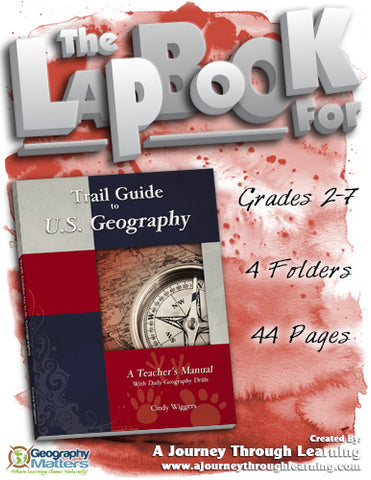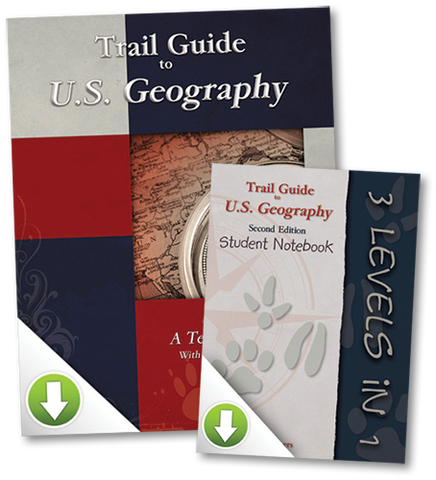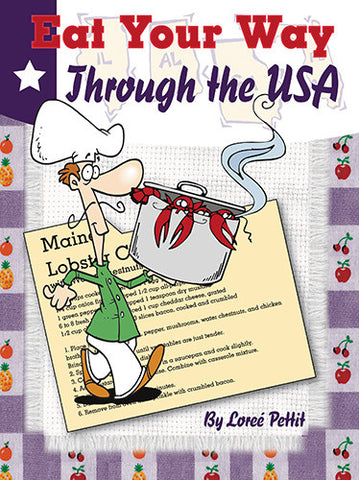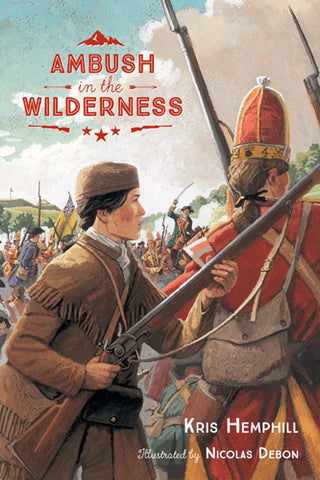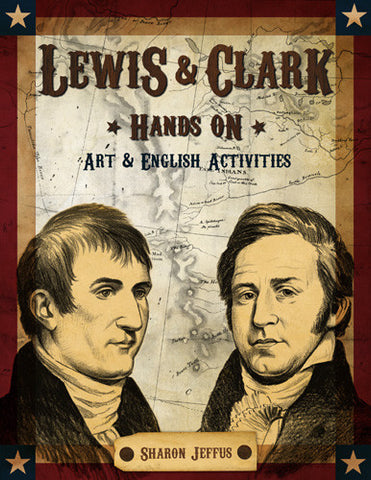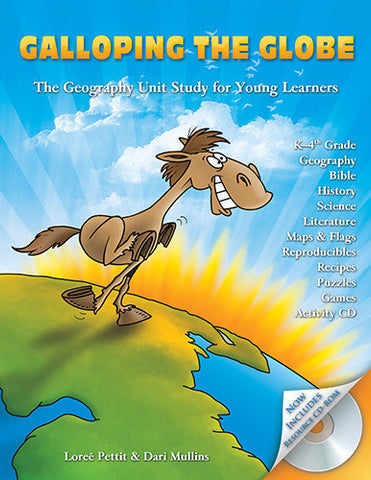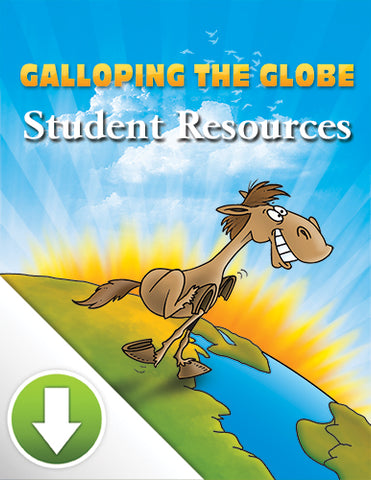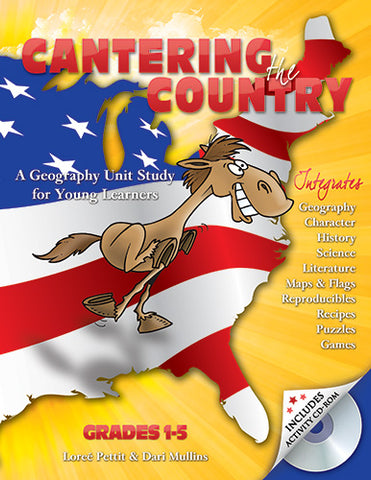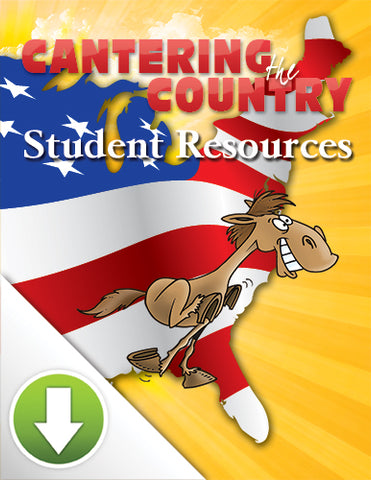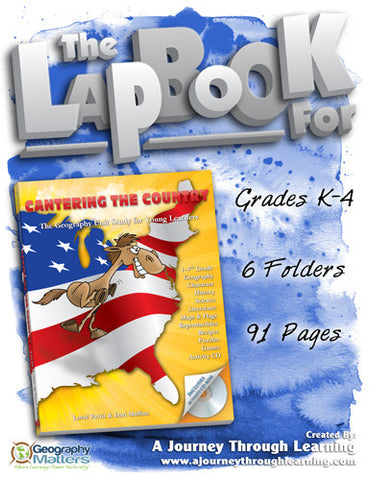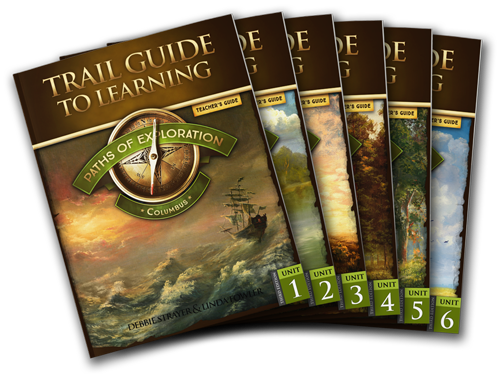
Paths of Exploration 3rd Edition - Teacher Guides
by Debbie Strayer & Linda Fowler
The Paths of American History begin with Exploration.
Following the steps of famous explorers and pioneers across America, let geography be your guide to science, history, language skills, and the arts. This journey teaches students HOW to think by asking, answering, and investigating questions about our great country's beginning and growth. The paths of the explorers are seen through multidisciplinary eyes, but always with the same goals: to make learning enjoyable, memorable, and motivating.
This full one-year course is ideal for 3rd, 4th, and 5th graders. Every subject but math is covered in Paths of Exploration.
For more details about the curriculum, including our educational approach, please download this Trail Guide to Learning series brochure and view the additional samples and information in the "Samples" tab, above.
Required student notebook pages are available for each grade level and are an integral part of this curriculum. Notebook pages provide maps, charts, space for copywork or dictation and any other template page needed throughout the year. Student Notebooks are not included with the Teachers Guide, but you can order them here.
Digital downloads of all three levels (4th, 5th, and 6th grades) of the Student Notebooks are included with the Complete Package and with each individual Unit Package.
These extensions provide additional assignments and activities for the age groups below. They do not stand alone, but are meant to be used alongside the main Teacher’s Guide.
Below, you will find a summary of each unit and a list of the resources that are used only during that unit. Additional resources and books are used throughout the year.
Core Resources are used throughout the year in nearly every unit.
Since Christopher Columbus is widely regarded as one of the first to encounter the New World, the study of his voyages and explorations begin our journey. As travelers, we start with the basics of geography such as maps, the compass rose, globe skills, oceans and continents. Learning about early navigation, the sun, stars, planets and constellations take center stage as well as developing the skills of observation and recording. Our literature reveals the hopes, dreams and struggles of Columbus and the importance of staying with what you do best. Using the wildlife handbook we can see the animals and wildlife that Columbus and his crew observed and learn about life aboard ship. You will journey back to a time when dreams of discovery led men to risk all and then watch as they sought to make the most of the opportunities they were given.
ResourcesIn addition to the core resources, the Columbus unit uses the following materials:
- Meet Christopher Columbus by by James T. deKay
- Christopher Columbus by Bennie Rhodes
- RealEarth® GlobeMap
Like all explorers, the colonists of Jamestown had their hopes and dreams. Leaving the limitations of the Old World behind, these sojourners in the New World found many challenges. This unit highlights the connection between history, geography and science as climate, terrain and culture determine many of the struggles faced by the Jamestown colonists. The clash between the customs of the Old World and the necessities of the New World are played out in the literature through drama and adventure as unknowns as well as famous names play their parts in the story of Jamestown. We see the importance of letter writing and the beauty and power of words to communicate the events and strong emotions tied to this endeavor. Never were the connections of home so important to survival and the faithfulness of a few so timely.
ResourcesIn addition to the core resources, the Jamestown unit uses the following materials:
- A Lion to Guard Us by Clyde Robert Bulla
- Surviving Jamestown by Gail Karwoski
- Jamestown Student Notebook pages
The lives and journeys of the Pilgrims were shaped by their deeply held beliefs which guided them around Europe and ultimately across the Atlantic Ocean. The hope of freedom that was in them was a driving force which led them through many trials and carried them during times of hardship. Our students learn how to give answers and use context to determine meaning, deepening their ability to comprehend and respond to the circumstances of life. History sets a rich feast of people and places as well as habitat and wildlife as the backdrop to the life and death struggle of the Pilgrims. Narrative writing connects their experiences showing the flow of events as well as the importance of cause and effect. Reflecting the articulate speech of the Pilgrims, we learn about the nuts and bolts of words and word meanings as well as the everyday life of a Pilgrim family. Once again we take inspiration from those who have gone before us, who set a course and followed it with all their strength, leaving us a legacy of freedom.
ResourcesIn addition to the core resources, the Pilgrims unit uses the following materials:
- Squanto, Friend of the Pilgrims by Clyde Robert Bulla - out of print. No longer provided in the package. Available used.
- Stories of the Pilgrims by Margaret Pumphrey
- Stories of the Pilgrims Answer Key
- Sarah Morton’s Day by Kate Waters
- Samuel Eaton’s Day by Kate Waters — Please note that this title has gone out of print and is no longer included in the package. The pricing has be reduced accordingly. Please visit the Updates page to watch a read-aloud video of this book.
- Pilgrims Student Notebook pages
Did you know that the Boy Scouts were patterned after Daniel Boone? He was a skilled hunter and observant tracker at a very young age, able to live off the land, earning him the praise of his father and many others in their community. You will study him and his family not only because of his skill but also because of his love for nature and his determination to lead the way for others to follow. In this unit you will learn about hiking, tracking, maps and communicating when separated by distance or language. All of these skills are studied in the context of the forests of America, including the Appalachian Trail. You will take an in depth look at trees and insects and their connections to other aspects of life in the wilds. Examining these topics also gives you the perfect opportunity to write about them, to explain what you have learned. This unit takes a look into the history of our land and its peoples, as well as an introduction to the move west of the growing frontier.
ResourcesIn addition to the core resources, the Daniel Boone unit uses the following materials:
- Daniel Boone, Frontiersman by Janet & Geoff Benge
- Daniel Boone, Young Hunter and Tracker by Augusta Stevenson (This book is currently out of print and is not included in this package. You can find used copies online.)
- 1911 Boy Scouts Handbook
- Daniel Boone Student Notebook pages
The spirit of Daniel Boone continues with Lewis and Clark and the Corps of Discovery as they travel farther west than any other American emissaries. Journaling was an important part of their role as explorers, making illustrations and writing descriptions of all the unusual sights they saw. Encouraging keen observation, your study of plant and animal life continues with the new and exciting sights found on the trail into the northwest. Equally novel is the study of the states of matter and the water cycle connected to their travels. With real accounts of their adventures, primary source documents make real the adventure, danger and exhilaration of success experienced by the group, including the exploits of a remarkable Native American woman, Sacagawea. Join the Corps as they travel to points unknown at the behest of their friend and president, Thomas Jefferson.
ResourcesIn addition to the core resources, the Lewis & Clark unit uses the following materials:
Your travels conclude with famous folk heroes and a family traveling the trail out west. Both were drawn to the opportunities and the wide-open spaces of the west, all the while measuring the cost and challenge of such a journey. With history and folk tales mixing to tell our story, wisdom comes forth as neighbor helped neighbor, everyone working hard, yet always saving a bit to share with a welcome stranger. Separating detail from the significant, students learn to identify main events as well as to read the intentions of individuals. The journey is completed with a review and reminder of all that has gone before—the successes and struggles, the pain and the joy of lives lived for the purpose of opening our great nation to those millions who would follow from all corners of the earth. Come along as these brave men, women and children guide you along the Paths of Exploration!
ResourcesIn addition to the core resources, the Trails West unit uses the following materials:
- Trouble for Lucy by Carla Stevens
- Johnny Appleseed by David R. Collins
- If You Traveled in a Covered Wagon by Ellen Levine
- Trails West Student Notebook pages
If you have landed on this page and haven’t yet learned much about the Trail Guide to Learning curriculum series, we recommend you read the intro to Trail Guide to Learning. Then come back to see what Paths of Exploration is all about!
"What I love about Paths of Exploration:
- All of the lessons are planned out for me. I simply print out any worksheets or maps I need for the week, grab the curriculum and follow along. [Student pages, or worksheets, are also available pre-printed and ready to use.]
- Biblical worldview. [Yet contains no Biblical content, so this curriculum qualifies for programs paid with government funding.]
- The curriculum covers History, Geography, Science, Grammar, Reading, Art, Nature Study, and Spelling.
- All of my children are learning the same thing for all subjects {except math}.
- The Unit Study approach ties all of the subjects together in a way that really furthers retention.
- There are extras that you can add-on for even more learning {lapbooks, Bible supplement, Middle School Supplement}.
- It is rooted in the education philosophies of Dr. Ruth Beechick.
- Paths of Exploration marries nicely with Charlotte Mason.
- Encourages engagement with dictation, discussion, and writing.
- The kids love it. There have been no complaints about school with Paths of Exploration. They love the readings, enjoy the maps and activities, and clamor for the Nature Study. They even enjoy the copywork and dictation! And, they finally get regular art in each week.
- The living books chosen as the base for this curriculum are wonderful. You even get to cook, using the cookbook, Eat Your Way Around the World, by Jamie Aramini.
- I finally have a guide to incorporate Nature Study into our homeschool.
- Geography Matters is a home-based company, located in Kentucky.
What I don’t love- Truly, honestly, I don’t think there is anything I would change. If I did, I would tell you-trust me. This curriculum has been an answer to prayers! Since we began Paths of Exploration, our days have been better, the kids have loved the lessons, and mom finally feels peace about how everything is working together. Our homeschool feels like we are on the right path. {No pun intended!}
—Sam's Noggin Blog
"I am anxiously awaiting the release of the program. If and when you plan on taking preorders, please let me know. I have most of the books already and we are raring to go. My boys (yes, I do mean it) really want to start the program. We used the sample and by Friday, they were asking for it. Even the writing part. God's Blessings to you and all who worked so hard on this curriculum."
—K. Phillips
"I very much enjoyed the historical fiction books. They helped in making the history more real and come alive for my kids. The Reader's Digest N. American Wildlife is a great quick resource. I enjoyed watching my kids draw pictures from it. The work for the kids was just about right. It wasn't too much or too little. My son is not crazy about drawing. But, I have to say, his drawing seemed to get better and better each time. My daughter liked the drawing and we all enjoyed reading the historical fiction stories. My son is pretty independent with his school work and by using Paths of Exploration, it allowed us the opportunity to come together with the reading time, discussion, etc. which is something I really enjoyed."
—M. Lindsey
"Here's a fun story. One school day I couldn't find Surviving Jamestown on the bookshelf. When I asked the children to help me find it, my daughter ran to her room and retrieved the book. After apologizing, she said she wanted to know what happened in the next chapter and ended up reading the entire book! Now, how could I be upset with that? "
—Reader
"When we received our resource books for the program, we were a bit intimidated by the thickness of some of the books. In fact, the kids said 'Whoa Mom, what have you gotten us into now!' It is amazing how I have found my son, more than once, reading the North American Wildlife Guide 'just for fun'. Thanks for the 'intimidation.'"
—R. Nelson
"Dr. Beechick's principles are the basis for this curriculum. During its creation, I had the privilege of consulting with her. Teaching in a natural manner is important to her and we reflected her values by incorporating language skills and history as a unified part of the everyday routines. Thank you, Dr. Beechick."
—Author, Debbie Strayer
"Oh my goodness yes it arrived!! We have already started this week and are really having fun with it. It's all I can do to keep the children from reading everything out of sequence. The only complaint I've had so far is the reading selections from day to day are just too short! They want more...didn't expect that with Columbus...thought I'd get it later with Squanto or Lewis & Clark for sure. Thank you for the quick service and for another wonderful curriculum selection! You have certainly blessed this family with your talent and insight."
—Deanna
"We have enjoyed Paths of Exploration and are just finishing Lewis and Clark. We have enjoyed looking back at all the wonderful material completed. Their improvement in writing and drawing have really stood out. I have also liked the critical think elements such as "reflective thinking." We have used [curriculum X] in the past and love literature based material but this curriculum has really eased our load without compromise. In fact, since it is more user friendly I find we are completing more material. Thanks for having my kids and me in mind when you designed Paths of Exploration. We are already looking forward to Paths of Settlement."
—Vicky
"I ordered Trail Guide to Learning this past Tuesday and received it a mere two days later! Wow! Kudos to your customer service department! I am so happy with the curriculum thus far. It is extremely well-laid out and very easy to implement. I have [curriculum X] I've tried to use [curriculum Y] and ended up selling them after a few weeks. You have brought together the best elements of all of those and then some and put it together in a way that makes sense and is easy to use. I know people will want to tweak and add things, especially grammar, but I'm with Dr Beechick and plan to wait until high school for formal grammar instruction. I also love the teaching notes. They provide handholding without being scripted. They help me to understand what my children should be taking away from each lesson and provide opportunities for discussion. Your curriculum is an answer to my prayers. Thank you!"
—Ann
"Paths of Exploration has restored my joy and confidence in our homeschooling. My children have not only enjoyed school more but they have grown tremendously in their ability to think through and communicate ideas with clarity and depth. We have many thrilling stories of triumph that started in struggles as my children were challenged beyond their natural abilities to discuss, to write, to draw or present their work. I am eternally grateful for how my own views of what learning really is have been transformed so that we can be free to love learning together."
—Elyce
"I have been using Paths of Exploration this past school year and I am very happy with it. I am looking forward to Paths of Settlement. I am wondering if a list is available for the books that will be used so I can begin planning and preparing. Thanks so much for any information you might have and thank you for this wonderful, innovative curriculum!"
—Amy
"We just started home schooling last week. Fourth and Eighth grade, POE. Love it so far!"
—B. Hedrick
"We just started using POE at the end of last year, and I balked about it for a while thinking it wouldn't be for us after all, but when I finally gave it a chance, we LOVED it! I'm homeschooling a 4th and 6th grader using POE! Thanks for such a wonderful curriculum!"
—S. Mitchell
"Hi there - we started POE this year with a 4th and 7th grader. What we like most about it are the readers. The kids get so excited when the historical figures (most of whom seem fictional to them) start appearing in more than one reader! History really comes alive to them when they realize that the "storybook characters" were actually real people!"
—B. Piscoya
"My 11 y.o. is on the third year of this curriculum and it has been a great curriculum to use, with enough variety of activities to keep even this mom from getting bored :) while staying organized with the lessons written out..."
—M. Martin
"I have to say after discovering Trail Guide to Learning ( we are in our 2nd year of it ), that I finally enjoy homeschooling. This has been our first curriculum that we all decided we wanted to do again. I had my children write about what they liked about their school year and my daughter wrote, 'I loved everything.' From a child who struggles, this was a huge blessing. Thank you all!!!"
—K. Grass
"I am using Trail Guide to Learning: Paths of Exploration this year with my 11 year old and 8.5 year old. As you have probably realized, this was written by the same two women who wrote the LLATL series (Debbie Strayer and Linda Fowler).
I give this program my highest recommendation. This is by far one of our best years in homeschooling. I don't know how many children you have, or how old they are, but this curriculum has been the perfect fit for my family this year.
"I love that all subjects, with the sole exception of math, are woven together—my kids are absorbing so much more and are enjoying their learning in the way that I've always hoped they would. Each week, we are reading together, drawing together, learning about geography, science, history together. My children are appreciating more of the reasons WHY people did the things they did:
- what motivated Christopher Columbus to explore
- why didn't Columbus sail directly west into the Atlantic Ocean?
- what about John Smith's life prepared him to become a leader in Jamestown?
- what were the reasons the Pilgrims felt lead to leave their comfortable homes in England to seek a new land in which to live?
Although there is consistency in some skill areas from day to day, there is also a tremendous variety in what we are doing—this keeps it fresh for the kids.
The student notebook at first glance appears dull—black and white pages that I print out and put into a binder for the kids. However, as they are adding their writing and drawings, completing maps, etc. in the notebooks, they become a wonderful body of work that they already are enjoying going back and reviewing.
I have used various different curricula over the past number of years with varying levels of success. I can honestly say that for me, at this point in our family/homeschooling life, this is the best fit."
—Liz
"Paths of Settlement arrived yesterday, and I wanted to tell you how excited we are to begin school soon! I also wanted to thank you for putting all of the teacher's resources on the cd-rom with the student resources. That is such a huge help, and I wanted to tell you that I really appreciate your thoughtfulness and attentiveness in helping to make homeschooling flow even more smoothly for us Moms. This homeschool curriculum has been such an answer to prayer for us, and such a rich blessing in so many ways. My kiddos I'm homeschooling are in 4th and 6th grades this year, so we are so grateful we found POE last year and are growing with this curriculum series."
—J. Garrido
"In the spring, while learning about Daniel Boone, my father was cutting hay and noticed a bee swarm…(he personally in 40 years of farming had never seen one) he called us to come see it b/c he had heard my children talking about bees and Daniel Boone one day. I can tell you that we would not have normally cared one bit about a bee swarm…until POE. Not to mention our trip to Jamestown…we live in Virginia and have passes to Williamsburg/Jamestown and we have never experienced Jamestown with so much excitement and knowledge until POE as well! I appreciate this forum, the writers, and users of TGTL, thanks again for answering my question and putting together an awesome adventure in homeschooling."
—D. Amiss, posting in the Trail Guide to Learning Series Yahoo Group
"I am so excited about this new curriculum I am using I just have to share! It is called Trail Guide to Learning and it is produced by the Geography Matters people. It is based on Ruth Beechick's methods. I am just loving it. We just finished the first 6 weeks—which completes the first unit. It was such a sense of accomplishment to finish the unit and then do the included assessment on my kids. They really retained the materials! It has everything included except math. The lessons are short and easily geared to lower level students. It's so simple, I feel like I am short-changing them, until I did the assessments and found out how much they learned. There are lapbooking activities for my 2nd grader and much harder writing assignments for my 5th grader. We do everything together, so I don't have to prepare two totally different lesson plans. I really love the books that we are reading. I just love this curriculum! … I am doing the Paths of Settlement. If you are looking for something, check this one out!"
—G. Moss
- Sample Lesson, first week of Unit 1- Columbus
- Table of Contents for all units)
- Skills Charts for each unit according to grade levels and topics studied
- Student Notebook Pages: 3rd Grade Sample, first week of Unit 1- Columbus
- Student Notebook Pages: 4th Grade Sample, first week of Unit 1- Columbus
- Student Notebook Pages: 5th Grade Sample, first week of Unit 1- Columbus
- Paths of Exploration ISBN List for all required resources used for the year
- Lesson At A Glance sample, sample planning charts for the first three weeks of the Columbus unit
- Trail Guide to Learning Series brochure, a complete 16-page brochure of the philosophy, presentations, and details of all three path levels of the curriculum
Reviews
| Publisher: | Geography Matters |
| ISBN: | 9781628630237 |
| Edition: | Third Edition, 2016 |
| Product: | |
| Format: | Premium Softcover |
| Size: | 8.5" x 11" |
What improvements and updates were made for this edition?
The Third Edition of Exploration is in six, soft-back books. Each book contains one unit which provides six weeks of lessons. You can purchase the curriculum one unit at a time or save $45 when buying them all at once. Each book is redesigned with a new look and includes full-color game cards with perforated edges for convenient use. You will also find the Lesson at a Glance pages (available for viewing under the “Samples” tab) placed in the back of each unit with perforated edges so that parents can easily check off assignments as they go and keep a log of completed work.
For what grade levels was this curriculum written?
Third, Fourth, and Fifth
Can you adapt this program for older students if so, how?
You can use the Enrichment Activities included in the sourcebook to make it appropriate for a sixth grader. In addition to that, take them to the library and get whatever books you can find, or use the internet to find as much as they can on the unit topic (discovery of the New World, the American Frontier, etc.) and as they read their resources, have them compare (tell what is the same as our resources) and contrast (tell what is different from our resources). This is a good critical thinking idea. Another quicker and easier way to do this is to find videos on each topic that you think are appropriate and then compare/contrast them with what our resources have to say about these folks. Encourage your older students to share the information they find out with you. This is a good thinking/presenting skill, as well as a way to develop summarizing ability.
A Middle School Supplement is also available to provide guidance for older students. Content follows along with the sourcebook but at a higher, more challenging level. It includes higher level literature books, writing assignments, activities, and thinking skill points. Connect all your students to the same time period and type of learning with the Trail Guide to Learning series Middle School Supplement. (Available in digital format.)
How many levels are used to teach American history?
We teach American History using a three-year program. Here is a summary of the three Paths.
Paths of Exploration — (Grades 3-5) The character and experiences of explorers who shaped us as a nation with their vision, determination, bravery and sacrifice. They blazed a trail for others to follow. The focus here is on the type of thinking, leadership and skills that were needed to open up the way for others to follow. Primary science focus involves acquiring the basic skills of observation and recording (both drawing and writing), beginning life science through studying the animals and plant life of explored areas, including habitats and the relationship of these factors to the explorers. Some key figures studied: Columbus, the Jamestown settlers, the Pilgrims, Daniel Boone and Lewis and Clark.
Paths of Settlement — (Grades 4- 6) The settling of our nation is examined through the lives of leaders who made a difference by standing for their beliefs and making a way for us as a nation to follow and grow. Key events studied - the Colonial Period, the Revolutionary War, the War of 1812, the Civil War and Westward Expansion. What does it take to build a nation? Blazing a trail was the first step, building a foundation for growth and government is next. Primary science focus - Earth Science (geology, weather, land forms, climate) and the impact of these factors on settlement. Basic economics and international relationships are also addressed. Some key figures studied include George Washington, Paul Revere, Abigail Adams, Francis Scott Key, Clara Barton, Robert E. Lee, and Abraham Lincoln.
Paths of Progress — (Grades 5-7) To grow as a country, another group of leaders had to step forward during our history - scientists and inventors. They used their talents and abilities to answer questions that provided better ways of living and working. The lives of these devoted individuals and their contributions will be examined throughout our history, into the Industrial Revolution and the beginning of the 20th century. Primary science focus — physical science (such as energy, motion, atoms and molecules) and the geographic and economic impact of each development. Some key figures studied: Ben Franklin, Samuel Morse, George Washington Carver, the Wright Brothers, and Thomas Edison.
What are the resources necessary to complete Paths of Exploration? Are they included, or do they need to be purchased separately?
Students will need the readers, read-aloud books, and a number of other reference materials and activity books. Every item is available separately or packaged in discounted sets.
The Exploration Complete Package includes the six curriculum teacher manuals, all resources listed on the product description page, and digital downloads of the student notebook pages.
Printed, ready-to-use, student notebook pages are available by grade and by unit. Buy 5 and get the 6th free when you order all 6 units together.
See the product description for a complete list of the Core and Unit Resources.
There are six units in Exploration. How long does it take to do each unit?
The first year of the Trail Guide to Learning series, Paths of Exploration, contains 36 lessons (each designed to take 5 days to complete) in 6 units, as follows:
Columbus — 6 weeks
Jamestown — 6 weeks
Pilgrims — 6 weeks
Daniel Boone — 6 weeks
Lewis & Clark — 6 weeks
Trails West — 6 weeks
Does Paths of Exploration use timelines?
Timeline activities are part of the Profiles from History, Volume 1 resource book.

